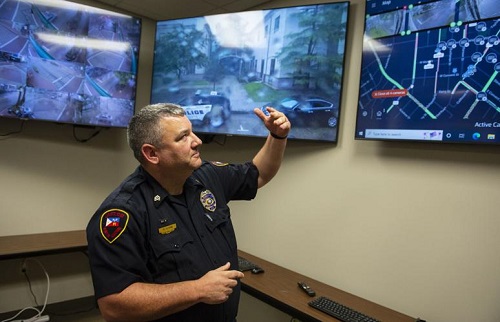
7.5.22 – Newsbreak
The Lafayette Police Department is using a new integrated surveillance system to connect police department, municipal and private cameras to speed investigations and gather real-time information while responding to calls.
The department had a soft public launch of the system at a Wednesday open house for the agency’s new downtown police precinct inside the Rosa Parks Transportation Center at 101 Jefferson St.
The system, Fusus, pulls a range of video sources — stationary surveillance cameras, portable police trailer cameras, license plate readers, traffic cameras, officer body worn cameras and in-unit dashboard cameras, as well as privately owned and municipal cameras — into a central, cloud-based database and map, Lafayette Police Sgt. Brad Robin said.
Robin, who oversees the department’s research and planning team, said the database can be accessed by officers on their in-unit computers and via an associated app on their phones.
“All of the officers can actually use this. It doesn’t matter where you are, they can get this from their unit. I can get it from my phone, anything. I can see everything going on,” Robin said.
In addition to the cloud-based access, the department also has two multi-monitor set-ups where officers can access the system in the new downtown precinct and in the department’s emergency operations center at headquarters.
The downtown center will help monitor high-density events, such as Festival International, unique to downtown. The set-up in the emergency operations center will allow officials to better track damage from natural disasters and make more informed deployment calls, Robin said.
The Lafayette Police sergeant said the department began testing the program in December. Since then, they’ve onboarded between 500 and 600 cameras into the cloud-based system and over the next month expect to complete onboarding officers’ dashboard and body-worn cameras. The system costs $100,000 annually, he said.
“What I tell everybody is all these locations with cameras are 24/7 police officers but I don’t have to feed them or do anything to them, except when they don’t work I’ll go take care of it. It’s got a memory and it doesn’t change,” Robin said.
C’est Tout
The top story in Acadiana in your inbox daily. You’re busy – This is all you need to read
This site is protected by reCAPTCHA and the Google Privacy Policy and Terms of Service apply.Sign Up
Robin said having a centralized surveillance network is useful for several reasons: officers can gather real-time information on an incident while en route, the video can be directly downloaded into the department’s evidence system to reduce the steps in their custody chain and investigators can plot a point on the system’s map and any connected cameras in the area will immediately be pulled up.
The system can also speed the review of stored video footage during investigations. Officers can give search commands to the system’s artificial intelligence, anything from flag silver vehicles to females in the area, and the system will pull video snippets showing every related hit, Robin Said.
“I don’t know if y’all have ever tried to watch 48 hours of video and you’re sitting there trying to find when the door opens one time — it’s rough. This will take it and I can say, ‘I want every person who came into this area,’ and it does it in seconds. We cut down that time sitting there watching from 48 hours to five seconds,” he said to the crowd at Wednesday’s open house.
So far three businesses have partnered with the department as early adopters to test how well the system can integrate private surveillance cameras. Robin said the department wanted to fine tune the process for onboarding businesses’ cameras before rolling the program out citywide, which Lafayette Police is working toward.
Businesses or residents interested in allowing the department access to their cameras have two pathways — registered or integrated cameras.
Registering a camera lets officers know where your camera is and provides contact information should they need footage, while integration connects your camera into their Fusus system and would allow officers to immediately tap into the footage if a crime occurred in the area, the sergeant said.
Robin said it was important to him that cameras at all price points could be accessed by the system. He requested the Georgia-based company test their technology with a Wyze camera, a low price point security camera running around $30, and it was successful. Coincidentally, the camera was left up after the test and months later it was used to help solve a homicide, the sergeant said.
The registered vs. integrated camera approach and other operational ideas were pulled from the Atlanta Police Department, who adopted the technology last year. Aside from knowledge sharing, agencies who use the Fusus system can also readily share video footage with one another, speeding cross-agency cooperation, Robin said.
While separate from the Lafayette Parish Sheriff’s Office’s Real Time Crime Center, the Lafayette Police Department’s Fusus network is accessible to the sheriff’s office.
